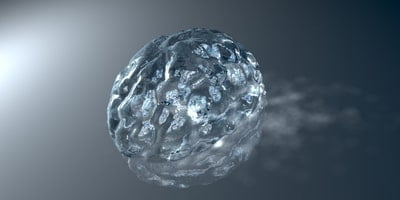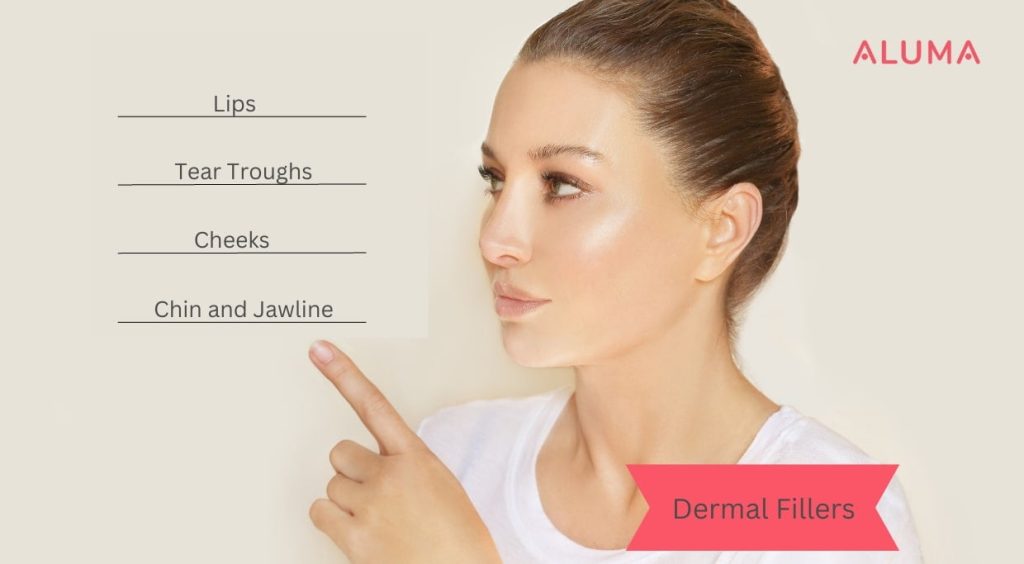Dermal fillers are soft-tissue injectable treatments that harmonize and refresh facial features, essentially pumping the brakes on aging. Over time, faces lose volume, support, and contour due to the normal aging process. Flattened cheeks can again have a nice, plump curvature with dermal filler injections. And, with that added volume in the cheekbones, the nasolabial folds diminish, goodbye to pesky parenthesis lines. Dermal fillers also act as a needed support system for the overlying musculature and fat pads when bones lose density. As we age, the bones comprising the orbital rim lose mass, and the eye sockets get larger, resulting in less support and structure around the eyes. Under-eye bags are the outward appearance of this organic anatomy change. Adding a support system back via dermal fillers improves the undereye bags. Lastly, another great function of dermal fillers is enhancing facial contours, such as jawline enhancement and lip augmentation. Thin lips on someone with a rounder face can appear out of harmony, and a recessed chin may look out of proportion in profile view. When injected holistically, dermal fillers balance features for a more beautiful and rested appearance.
Dermal Filler Composition
The main ingredient in most dermal fillers is hyaluronic acid, an essential part of the dermal matrix maintaining moisture, structure, and skin function. This molecule, a Glycosaminoglycan, is a repeating sugar molecule that naturally attracts water to its network. Our body naturally creates hyaluronic acid, but as we age, less and less is produced. Injectable hyaluronic acid-based dermal fillers use proprietary cross-linked hyaluronic acid, which helps them maintain their structure for long periods of time and enables them to be injected deep into the dermis for volume and support. Hyaluronic acid based dermal fillers (HA Fillers) are reabsorbed into the body over time, classifying them as temporary. HA Dermal Fillers, such as Juvederm Voluma, Restylane Kysse, and Revance RHA, is the most common dermal fillers used in aesthetic medicine because they can be reversed with hyaluronidase if the outcome is undesirable or if there is an adverse event.

The main ingredient in most dermal fillers is hyaluronic acid, an essential part of the dermal matrix maintaining moisture, structure, and skin function.
Other Types of Facial Rejuvenators
In addition to dermal fillers, other injectables exist that add volume to the face, such as poly-L-lactic acid in Sculptra (PLLA) or ploy-lactic-co-glycolic acid (PLGA) in the Silhouette Instalift Threads. Both are considered biostimulators rather than dermal fillers because they stimulate fibroblast activity, increasing collagen production. An increase in collagen also increases facial volume lost over time. Biostimulators do a nice job of firming the skin and adding a touch of volume, but they are unsuitable for some areas, such as the lips or highly mobile areas of the face. Although still considered a temporary treatment, like dermal fillers, biostimulators typically last two years. At Aluma, Dr. Brigham sees merit in a two-phase approach combining biostimulator treatments with dermal filler treatments for comprehensive rejuvenation.
Calcium hydroxylapatite, known as Radiesse in the aesthetic industry, is somewhat of a combination of dermal filler and biostimulator. Synthetic calcium hydroxylapatite (CaHA) stimulates collagen production, while the injectable’s gel matrix, an aqueous carboxymethylcellulose gel carrier, adds volume and support. Radiesse is commonly used in the hands to add volume and suppleness, and it is also FDA-approved for marionette lines. Since it is not easily reversed like hyaluronic acid-based dermal fillers, CaHA injections are not as commonly used.
Autologous fat transfer is another way to add volume to the face, and it can last from months to years. Fat must be harvested and then injected. Fat injections cannot be reversed in adverse events; thus, clinicians are less likely to use this method due to the 2-part process and the risks.

What to expect during dermal filler treatments
Dermal filler treatments at Aluma are typically 1-1.5 hours in length. An in-depth patient assessment and review of risks and complications, anatomy changes, and reasoning behind the injections are discussed. Then, ice is applied to the treatment area to reduce the chance of bruising by vasoconstricting the area while numbing the skin. Chlorhexidine is applied to sterilize the treatment area, and the dermal filler is then injected with a tiny needle, a cannula, or a mix of both. A cannula is a blunt-tipped needle that bends around blood vessels reducing the risk of vascular incidents. After a dermal filler treatment, patients typically return to daily activities as there is minimum downtime.
Dermal fillers offer a non-surgical alternative to facial rejuvenation and are ideal for people looking to restore lost volume, smooth out wrinkles, and enhance facial contours without undergoing surgery. They typically produce results lasting anywhere from nine months to eighteen months, depending on the type of filler used and the individual’s metabolism.
Choosing a qualified and experienced injector for dermal filler treatments is essential to ensure you get the best possible results and minimize the risk of complications.
With all our services, we remain current with the latest advancements and trends in aesthetic medicine and dermal fillers to provide you with the best outcomes and the most relevant and accurate information.
References:
Carruthers, Jean MD, FRCSC and Humphrey, Shannon, MD, FRCPC, FAAD. Injectable soft tissue fillers: Overview of Clinical Use. Uptodate. 2022.
Rorich RJ, Pessa JE, Ristow B. The youthful cheek and the deep medial fat compartment. Plastic reconstructive Surgery 2010; 125:332.

